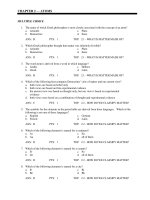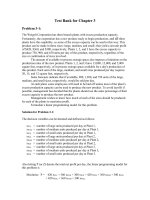Introduction to java programming comprehensive version 10th edition by liang test bank
Bạn đang xem bản rút gọn của tài liệu. Xem và tải ngay bản đầy đủ của tài liệu tại đây (442.93 KB, 32 trang )
Introduction to Java Programming Comprehensive Version 10th
edition by Y. Daniel Liang Test Bank
Link full download test bank: />Link full download solution manual: />Chapter 2 Elementary Programming
Section 2.3 Reading Input from the Console
1.
Suppose a Scanner object is created as follows:
Scanner input = new Scanner(System.in);
What method do you use to read an int value?
a. input.nextInt();
b. input.nextInteger();
c. input.int();
d. input.integer();
Key:a
2.
The following code fragment reads in two numbers:
Scanner input = new Scanner(System.in);
int i = input.nextInt();
double d = input.nextDouble();
What are the correct ways to enter these two numbers?
a. Enter
b. Enter
c. Enter
d. Enter
the Enter
Key:abc
an integer, a space, a double value, and then the Enter key.
an integer, two spaces, a double value, and then the Enter key.
an integer, an Enter key, a double value, and then the Enter key.
a numeric value with a decimal point, a space, an integer, and then
key.
6. _______ is the code with natural language mixed with Java
code. a. Java program
b. A Java statement
c. Pseudocode
d. A flowchart diagram
key:c
3. If you enter 1 2 3, when you run this program, what will be the output?
import java.util.Scanner;
public class Test1 {
public static void main(String[] args) {
Scanner input = new Scanner(System.in);
System.out.print("Enter three numbers: ");
Page 1
chapter2.txt
double number1 = input.nextDouble();
double number2 = input.nextDouble();
double number3 = input.nextDouble();
// Compute average
double average = (number1 + number2 + number3) / 3;
// Display result
System.out.println(average);
}
}
a.
b.
c.
d.
Key:b
#
4.
1.0
2.0
3.0
4.0
What is the exact output of the following code?
double area = 3.5;
System.out.print("area");
System.out.print(area);
a.
b.
c.
d.
Key:c
3.53.5
3.5 3.5
area3.5
area 3.5
#
Section 2.4 Identifiers
4. Every letter in a Java keyword is in lowercase?
a.
true
b.
false
Key:a
#
5. Which of the following is a valid identifier?
a.
$343
b.
class
c.
9X
d.
8+9
e.
radius
Key:ae
#
Page 2
chapter2.txt
Section 2.5 Variables
6.
Which of the following are correct names for variables according to
Java naming conventions?
a.
radius
b.
Radius
c.
RADIUS
d.
findArea
e.
FindArea
Key:ad
#
7.
a.
b.
c.
d.
Key:ab
Which of the following are correct ways to declare variables?
int length; int width;
int length, width;
int length; width;
int length, int width;
#
Section
8.
a.
b.
c.
d.
Key:c
2.6 Assignment Statements and Assignment Expressions
____________ is the Java assignment operator.
==
:=
=
=:
#
9.
a.
b.
c.
d.
e.
Key:b
To assign a value 1 to variable x, you write
1 = x;
x = 1;
x := 1;
1 := x;
x == 1;
#
10.
a.
b.
c.
d.
Key:cd
Which of the following assignment statements is incorrect?
i = j = k = 1;
i = 1; j = 1; k = 1;
i = 1 = j = 1 = k = 1;
i == j == k == 1;
#
Section 2.7 Named Constants
11.
To declare a constant MAX_LENGTH inside a method with value 99.98, you write
a.
final MAX_LENGTH = 99.98;
Page 3
b.
c.
d.
Key:d
chapter2.txt
final float MAX_LENGTH = 99.98;
double MAX_LENGTH = 99.98;
final double MAX_LENGTH = 99.98;
#
12.
a.
b.
c.
d.
e.
Key:ae
Which of the following is a constant, according to Java naming conventions?
MAX_VALUE
Test
read
ReadInt
COUNT
#
13.
instead
a.
b.
c.
d.
Key:c
To improve readability and maintainability, you should declare _________
of using literal values such as 3.14159.
variables
methods
constants
classes
#
Section 2.8 Naming Conventions
60.
According to Java naming convention, which of the following names can
be variables?
a.
FindArea
b.
findArea
c.
totalLength
d.
TOTAL_LENGTH
e.
class
Key:bc
#
Section
14.
a.
b.
c.
d.
Key:a
2.9 Numeric Data Types and Operations
Which of these data types requires the most amount of memory?
long
int
short
byte
#
34. If a number is too large to be stored in a variable of the float type, it
_____________.
a. causes overflow
b. causes underflow
Page 4
chapter2.txt
c. causes no error
d. cannot happen in Java
Key:a
#
15.
Analyze the following code:
public class Test {
public static void main(String[] args) {
int n = 10000 * 10000 * 10000;
System.out.println("n is " + n);
}
}
a.
The program displays n is 1000000000000
b.
The result of 10000 * 10000 * 10000 is too large to be stored in
int variable n. This causes an overflow and the program is aborted.
c.
The result of 10000 * 10000 * 10000 is too large to be stored in
variable n. This causes an overflow and the program continues to execute
because Java does not report errors on overflow.
d.
The result of 10000 * 10000 * 10000 is too large to be stored in
int variable n. This causes an underflow and the program is aborted.
e. The result of 10000 * 10000 * 10000 is too large to be stored in an int
n. This causes an underflow and the program continues to execute because
does not report errors on underflow.
Key:c
#
16. What is the result of 45 /
4? a. 10
b. 11 c.
11.25 d.
12
Key:b 45 / 4 is an integer division, which results in 11
#
18. Which of the following expression results in a value
1? a. 2 % 1
b. 15 % 4
c. 25 % 5
d. 37 % 6
Key:d 2 % 1 is 0, 15 % 4 is 3, 25 % 5 is 0, and 37 % 6 is 1
#
19. 25 % 1 is _____
a. 1
b. 2
c. 3
d. 4
Page 5
an
an int
an
variable
Java
chapter2.txt
e. 0
Key:e
#
20. -25 % 5 is _____
a. 1
b. 2
c. 3
d. 4
e. 0
Key:e
#
21. 24 % 5 is _____
a. 1
b. 2
c. 3
d. 4
e. 0
Key:d
#
22. -24 % 5 is _____
a. -1
b. -2
c. -3
d. -4
e. 0
Key:d
#
23. -24 % -5 is _____
a. 3
b. -3
c. 4
d. -4
e. 0
Key:d
#
30. Math.pow(2, 3) returns __________.
a. 9
b. 8
c. 9.0
d. 8.0
Key:d It returns a double value 8.0.
#
Page 6
chapter2.txt
30. Math.pow(4, 1 / 2) returns __________.
a. 2
b. 2.0
c. 0
d. 1.0
e. 1
Key:d Note that 1 / 2 is 0.
#
30. Math.pow(4, 1.0 / 2) returns __________.
a. 2
b. 2.0
c. 0
d. 1.0
e. 1
Key:b Note that the pow method returns a double value, not an integer.
#
31. The
a.
b.
c.
d.
Key:c
__________ method returns a raised to the power of b.
Math.power(a, b)
Math.exponent(a, b)
Math.pow(a, b)
Math.pow(b, a)
#
Section
15.
a.
b.
c.
d.
Key:c
2.10 Numeric Literals
To declare an int variable number with initial value 2, you write
int number = 2L;
int number = 2l;
int number = 2;
int number = 2.0;
#
32. Analyze the following code.
public class Test {
public static void main(String[] args) {
int month = 09;
System.out.println("month is " + month);
}
}
a. The program displays month is 09
b. The program displays month is 9
c. The program displays month is 9.0
d. The program has a syntax error, because 09 is an incorrect literal value.
Key:d Any numeric literal with the prefix 0 is an octal value. But 9 is not an octal
Page 7
chapter2.txt
digit. An octal digit is 0, 1, 2, 3, 4, 5, 6, or 7.
#
15. Which of the following are the same as 1545.534?
a.
1.545534e+3
b.
0.1545534e+4
c.
1545534.0e-3
d.
154553.4e-2
Key:abcd
#
Section
24.
a.
b.
c.
d.
e.
Key:c
2.11 Evaluating Expressions and Operator Precedence
The expression 4 + 20 / (3 - 1) * 2 is evaluated to
4
20
24
9
25
#
Section 2.12 Case Study: Displaying the Current Time
58. The System.currentTimeMillis() returns ________________ .
a.
the current time.
b.
the current time in milliseconds.
c.
the current time in milliseconds since midnight.
d.
the current time in milliseconds since midnight, January 1, 1970.
e.
the current time in milliseconds since midnight, January 1, 1970 GMT
(the Unix time).
Key:e
#
24.
a.
b.
c.
d.
e.
Key:c
To obtain the current second, use
System.currentTimeMillis() % 3600
System.currentTimeMillis() % 60
System.currentTimeMillis() / 1000
System.currentTimeMillis() / 1000
System.currentTimeMillis() / 1000
_________.
#
24.
a.
b.
c.
d.
e.
Key:d
To obtain the current minute, use
System.currentTimeMillis() % 3600
System.currentTimeMillis() % 60
System.currentTimeMillis() / 1000
System.currentTimeMillis() / 1000
System.currentTimeMillis() / 1000
_________.
% 60
/ 60 % 60
/ 60 / 60 % 24
% 60
/ 60 % 60
/ 60 / 60 % 24
Page 8
chapter2.txt
#
24.
a.
b.
c.
d.
e.
Key:e
To obtain the current hour
System.currentTimeMillis()
System.currentTimeMillis()
System.currentTimeMillis()
System.currentTimeMillis()
System.currentTimeMillis()
#
Section
24.
a.
b.
c.
d.
e.
Key:bde
2.13 Augmented Assignment Operators
To add a value 1 to variable x, you write
1 + x = x;
x += 1;
x := 1;
x = x + 1;
x = 1 + x;
in UTC, use _________.
% 3600
% 60
/ 1000 % 60
/ 1000 / 60 % 60
/ 1000 / 60 / 60 % 24
#
25.
To add number to sum, you write
a.
number += sum;
b.
number = sum + number;
c.
sum = Number + sum;
d.
sum += number;
e. sum = sum + number;
Key:de
(Note: Java is case-sensitive)
#
26.
a.
b.
c.
d.
e.
Key:d
Suppose x is 1. What is x after x += 2?
0
1
2
3
4
#
27.
a.
b.
c.
d.
e.
Key:a
Suppose x is 1. What is x after x -= 1?
0
1
2
-1
-2
#
Page 9
28.
chapter2.txt
What is x after the following statements?
int x = 2;
int y = 1;
x *= y + 1;
a. x is
b. x is
c. x is
d. x is
Key:d
#
29.
1.
2.
3.
4.
What is x after the following statements?
int x = 1;
x *= x + 1;
a. x is
b. x is
c. x is
d. x is
Key:b
#
29.
1.
2.
3.
4.
Which of the following statements are the same?
(A) x -= x + 4
(B) x = x + 4 - x
(C) x = x - (x + 4)
a. (A) and (B) are the same
b. (A) and (C) are the same
c. (B) and (C) are the same
d. (A), (B), and (C) are the same
Key:a
#
Section 2.14 Increment and Decrement Operators
21.
Are the following four statements equivalent?
number += 1;
number = number + 1;
number++;
++number;
a. Yes
b. No
Key:a
Page 10
chapter2.txt
#
34. What is i printed?
public class Test {
public static void main(String[] args)
{ int j = 0;
int i = ++j + j * 5;
System.out.println("What is i? " + i);
}
}
a. 0
b. 1
c. 5
d. 6
Key:d Operands are evaluated from left to right in Java. The left-hand operand of a
binary operator is evaluated before any part of the right-hand operand is
evaluated. This rule takes precedence over any other rules that govern expressions.
Therefore, ++j is evaluated first, and returns 1. Then j*5 is evaluated, returns 5.
#
35. What is i printed in the following code?
public class Test {
public static void main(String[] args) {
int j = 0;
int i = j++ + j * 5;
System.out.println("What is i? " + i);
}
}
a. 0
b. 1
c. 5
d. 6
Key:c Same as before, except that j++ evaluates to 0.
#
36. What is y displayed in the following code?
public class Test {
public static void main(String[] args) {
int x = 1;
int y = x++ + x;
System.out.println("y is " + y);
}
}
a. y is 1.
b. y is 2.
Page 11
chapter2.txt
c. y is 3.
d. y is 4.
Key:c When evaluating x++ + x, x++ is evaluated first, which does two things: 1.
returns 1 since it is post-increment. x becomes 2. Therefore y is 1 + 2.
#
37. What is y displayed?
public class Test {
public static void main(String[] args) {
int x = 1;
int y = x + x++;
System.out.println("y is " + y);
}
}
a. y is 1.
b. y is 2.
c. y is 3.
d. y is 4.
Key:b When evaluating x + x++, x is evaluated first, which is 1. X++ returns 1
since it is post-increment and 2. Therefore y is 1 + 1.
#
Section
38.
a.
b.
c.
d.
Key:d
2.15 Numeric Type Conversions
To assign a double variable d to a float variable x, you write
x = (long)d
x = (int)d;
x = d;
x = (float)d;
#
17. Which of the following expressions will yield
0.5? a. 1 / 2
b. 1.0 / 2
c. (double) (1 /
2) d. (double) 1 /
2 e. 1 / 2.0
Key:bde 1 / 2 is an integer division, which results in 0.
#
39. What is the printout of the following code:
double x = 5.5;
int y = (int)x;
System.out.println("x is " + x + " and y is " +
y); a. x is 5 and y is 6
b. x is 6.0 and y is 6.0
Page 12
c. x is 6 and y
d. x is 5.5 and
e. x is 5.5 and
Key:d The value
chapter2.txt
is 6
y is 5
y is 5.0
is x is not changed after the casting.
#
40. Which of the following assignment statements is illegal?
a.
float f = -34;
b.
int t = 23;
c.
short s = 10;
d.
int t = (int)false;
e.
int t = 4.5;
Key:de
#
41. What is the value of (double)5/2?
a.
2
b.
2.5
c.
3
d.
2.0
e.
3.0
Key:b
#
42. What is the value of (double)(5/2)?
a.
2
b.
2.5
c.
3
d.
2.0
e.
3.0
Key:d
#
43. Which of the following expression results in
45.37? a. (int)(45.378 * 100) / 100
b. (int)(45.378 * 100) /
100.0 c. (int)(45.378 * 100 /
100) d. (int)(45.378) * 100 /
100.0 Key:b
#
43. The expression (int)(76.0252175 * 100) / 100 evaluates to
_________. a. 76.02
b. 76
c. 76.0252175
d. 76.03
Key:b In order to obtain 76.02, you have divide 100.0.
Page 13
chapter2.txt
#
44.
will be
a.
b.
c.
d.
Key:d
If you attempt to add an int, a byte, a long, and a double, the result
a __________ value.
byte
int
long
double
#
Section 2.16 Software Life Cycle
1. _____________ is a formal process that seeks to understand the problem
and document in detail what the software system needs to do.
a. Requirements
specification b. Analysis
c. Design
d.
Implementation
e. Testing Key:a
#
1. _____________ System analysis seeks to analyze the data flow and to identify
the system’s input and output. When you do analysis, it helps to identify what the
output is first, and then figure out what input data you need in order to produce
the output.
a. Requirements
specification b. Analysis
c. Design
d.
Implementation
e. Testing Key:b
#
0.
Any assignment statement can be used as an assignment expression.
a. true
b. false
Key:a
#
1.
You can define a constant twice in a block.
a. true
b. false
Key:b
#
44. _____ are valid Java
identifiers. a. $Java
b. _RE4
Page 14
chapter2.txt
c. 3ere
d. 4+4
e. int
Key:ab
#
2.
You can define a variable twice in a block.
a. true
b. false
Key:b
#
3.
The value of a variable can be changed.
a. true
b. false
Key:a
#
4.
The result of an integer division is the integer part of the division;
the fraction part is truncated.
a. true
b. false
Key:a
#
5.
You can always assign a value of int type to a variable of long type
without loss of information.
a. true
b. false
Key:a
#
6.
You can always assign a value of long type to a variable of int type
without loss of precision.
a. true
b. false
Key:b
#
13.
A variable may be assigned a value only once in the program.
a. true
b. false
Key:b
#
14.
You can change the value of a constant.
a. true
b. false
Page 15
chapter2.txt
Key:b
#
2.
a.
b.
c.
d.
Key:d
To declare a constant PI, you write
final static PI = 3.14159;
final float PI = 3.14159;
static double PI = 3.14159;
final double PI = 3.14159;
#
3.
a.
b.
c.
d.
Key:c
To declare an int variable x with initial value 200, you write
int x = 200L;
int x = 200l;
int x = 200;
int x = 200.0;
#
4.
a.
b.
c.
d.
Key:b
To assign a double variable d to an int variable x, you write
x = (long)d
x = (int)d;
x = d;
x = (float)d;
#
8.
a.
b.
c.
d.
Key:a
Which of the following is a constant, according to Java naming conventions?
MAX_VALUE
Test
read
ReadInt
#
9.
a.
b.
c.
d.
Key:d
Which
float
int t
short
float
#
10.
a.
b.
c.
d.
of the following assignment statements is illegal?
f = -34;
= 23;
s = 10;
f = 34.0;
A Java statement ends with a __________.
comma (,)
semicolon (;)
period (.)
closing brace
Page 16
chapter2.txt
Key:b
#
11.
a.
b.
c.
d.
Key:b
The assignment operator in Java is __________.
:=
=
= =
<-
#
12.
a.
b.
c.
d.
Key:d
Which of these data types requires the least amount of memory?
float
double
short
byte
#
13.
a.
b.
c.
d.
Key:a
Which of the following operators has the highest precedence?
casting
+
*
/
#
17.
will be
a.
b.
c.
d.
Key:a
If you attempt to add an int, a byte, a long, and a float, the result
a __________ value.
float
int
long
double
#
18.
If a program compiles fine, but it terminates abnormally at runtime,
then the program suffers __________.
a.
a syntax error
b.
a runtime error
c.
a logic error
Key:b
#
24.
a.
b.
c.
What is 1 % 2?
0
1
2
Page 17
chapter2.txt
Key:b
#
26. What is the printout of the following code:
double x = 10.1;
int y = (int)x;
System.out.println("x is " + x + " and y is " + y);
a. x is
b. x is
c. x is
d. x is
e. x is
Key:d
10 and y
10.0 and
11 and y
10.1 and
10.1 and
is 10
y is 10.0
is 11
y is 10
y is 10.0
#
32. The compiler checks
_______. a. syntax errors
b. logical errors
c. runtime errors
Key:a
#
33. You can cast a double value to
_______. a. byte
b. short
c. int d.
long e.
float
Key:abcde
#
34. The keyword _______ must be used to declare a
constant. a. const
b. final
c. static
d. double
e. int
Key:b
#
37. pow is a method in the _______
class. a. Integer
b. Double
c. Math
d. System
Key:c
Page 18
chapter2.txt
#
38. currentTimeMills is a method in the _______
class. a. Integer
b. Double
c. Math
d. System
Key:d
#
39. 5 % 1 is _____
a. 1
b. 2
c. 3
d. 4
e. 0
Key:e
#
40. 5 % 2 is _____
a. 1
b. 2
c. 3
d. 4
e. 0
Key:a
#
41. 5 % 3 is _____
a. 1
b. 2
c. 3
d. 4
e. 0
Key:b
#
42. 5 % 4 is _____
a. 1
b. 2
c. 3
d. 4
e. 0
Key:a
#
43. 5 % 5 is _____
a. 1
Page 19
chapter2.txt
b. 2
c. 3
d. 4
e. 0
Key:e
#
43. -5 % 5 is _____
a. -1
b. -2
c. -3
d. -4
e. 0
Key:e
#
43. -15 % 4 is _____
a. -1
b. -2
c. -3
d. -4
e. 0
Key:c
#
43. -15 % -4 is _____
a. -1
b. -2
c. -3
d. -4
e. 0
Key:c
#
43. A variable must be declared before it can be
used. a. True
b. False
Key:a
#
43. A constant can be defined using using the final
keyword. a. True
b. False
Key:a
#
43. Which of the following are not valid assignment
statements? a. x = 55;
Page 20
chapter2.txt
b. x = 56 + y;
c. 55 = x;
d. x += 3;
Key:c
Page 21
Sample Final Exam for CSCI 1302
FINAL EXAM AND COURSE OUTCOMES MATCHING
COURSE OUTCOMES
Upon successful completion of this course, students should be able to
1.
understand OO concepts: encapsulation, inheritance, polymorphism,
interfaces, abstract classes
2.
use Unified Modeling Language for design, analysis, and documentation
3.
develop graphical user interfaces
4.
develop event-driven programs
5.
use file I/O and handle exceptions
6.
design and implement OO programs
Here is a mapping of the final comprehensive exam against the course outcomes:
Question
1
2
3
4
5
Matches outcomes
1
2
3, 4, 5
6, 7
1, 2, 3, 4, 5, 6, 7
1
Name:_______________________
Covers chs8-19
Final Exam
CSCI 1302 Introduction to Programming
Armstrong Atlantic State University
Instructor: Dr. Y. Daniel Liang
Please note that the university policy prohibits giving the exam score by email. If you need to know your
final exam score, come to see me during my office hours next semester.
I pledge by honor that I will not discuss the contents of this exam
with anyone.
Signed by ___________________ Date ___________________
1. Design and implement classes. (10 pts)
Design a class named Person and its two subclasses named Student and
Employee. Make Faculty and Staff subclasses of Employee. A person has
a name, address, phone number, and email address. A student has a
class status (freshman, sophomore, junior, or senior). Define the
status as a constant. An employee has an office, salary, and date
hired. Define a class named MyDate that contains the fields year,
month, and day. A faculty member has office hours and a rank. A staff
member has a title. Override the toString method in each class to
display the class name and the person's name.
Draw the UML diagram for the classes. Write the code for the
Student class only.
2
2. Design and use interfaces (10 pts)
Write a class named Octagon that extends GeometricObject
and implements the Comparable and Cloneable interfaces.
Assume that all eight sides of the octagon are of equal
size. The area can be computed using the following formula:
area (2 4 / 2) * side * side
Draw the UML diagram that involves Octagon,
GeometricObject, Comparable, and Cloneable.
3
3. Design and create GUI applications (10 pts)
Write a Java applet to add two numbers from text fields, and
displays the result in a non-editable text field. Enable your
applet to run standalone with a main method. A sample run of the
applet is shown in the following figure.
4









